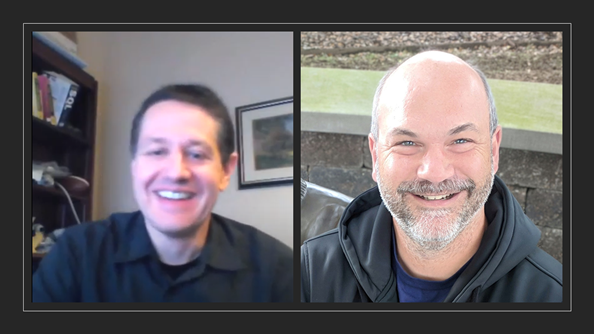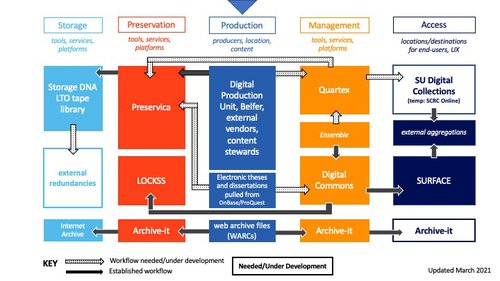The Digital Underground: Library Information Technology Services

by Brittany Bertazon, Graduate Assistant for Digital Library Program
Demystifying Digital Preservation and Deep Infrastructure with Library Information Technology Services
Today’s conversation features interviews conducted in September 2020 with Library Information & Technology Services (LITS) staff members Joseph “Joe” Foote and Russell “Russ” Silverstein. LITS is a vital partner of the DLP and assists in the evaluation, selection, licensing, implementation, and support of systems and infrastructure that propel DLP initiatives. LITS’ work is ubiquitous across the DLP. For example, Preservica (our digital preservation software) is hosted locally and supported by LITS. Digital Commons (a commercial, hosted institutional repository and journal publishing platform owned by Elsevier/bepress, which hosts SURFACE, the University’s open access institutional repository) and recently acquired Quartex (digital asset management software and future host to SU Libraries’ Digital Collections) are examples of ‘Software as a Service’ (SaaS). LITS is fundamental in the analysis, procurement, purchasing, support, and maintenance of SaaS for Syracuse University Libraries in conjunction with Déirdre Joyce, Head of the Digital Library Program.
Brittany: What does a typical day look like for you?
Russ: Crazy! Anything from helping a staff member with a desktop support request (needing software, troubleshooting headset sound issues or remote access issues…), building a new laptop, desktop, digital signage cart, or server, reviewing license agreements, purchasing software or hardware, reviewing requirements for software or hardware, managing priorities / projects / tasks for Library IT, troubleshooting system / software / hardware / server issues, budget review and projection, providing classroom support.
Joe: My typical day depends. If there is a project that I must work on, then I bunker in and work on that project. Otherwise, I have little projects that I continue to work on. Then I support calls, dealing with them as they come in. Between the LITS group, we all have different projects, and we all shift into support when we need to.
Brittany: How does your position contribute to and/or integrate with the Digital Library Program (DLP)?
Russ: I am a member of the preservation team. Preservation of library materials has been a topic and project I have been involved in since I started at SU Libraries 17 years ago. Things as simple as writing files to gold CDs because they were the preservation standard over aluminum. Researching preservation systems and storage. Assisting to a varying degree with implementing and supporting platforms such as Preservica, XTF, Mets, and bepress, the many systems that support DLP goals and initiatives.
Library IT is an active member of DLP teams. It is a good working relationship, and the workflow depends on the specific need or request. It varies from long term planning for major system changes to a simple request via Teams to make a change in Preservica to continue workflow steps.
Joe: I am one of the people that was part of the original DLP formation from an IT perspective project. I have been in those meetings for quite a while. I run the tape backup system, which is what we use to preserve our information.
I created and installed some of the servers, and I support those servers. I also support troubleshooting the different things that go wrong with Preservica. I work quite a bit with Deidre (Joyce), Michael (Dermody), and Suzanne (Preate) to help set up Preservica for the different storage adapters and other things like that.
Brittany: What does like your workflow normally look like between you and the DLP?
Joe: Depends on what it is. Suzanne or someone will reach out to me and say, “hey we need a new storage adapter for this new project” and then we will set up that storage adapter., We help set up the other parts, too, like the ingest and parts of Preservica to make sure everything flows through cleanly.
When they [other members of the DLP team] notify me that the data is full, I write a tape, verify the tape, duplicate the tape, and verify the duplicate. Then, we add barcodes to the tape. Finally, we store one here in the Library and one down in the Facility.

Figure 1: DLP Technical Infrastructure (Abstracted), This diagram shows the emerging DLP technical Infrastructure. Support from LITS touches nearly everything seen here, from hardware support for storage and production activities, to application support for tools used in preservation, and procurement support for externally supported Software as a Service (SaaS) tools.
Brittany: What equipment technology software do you use most frequently with the DLP?
Joe: We use Preservica as our preservation management system. For our tape backup system, we use StorageDNA software with an HP server and HP Linear Tape-Open (LTO) library. We also have servers where we store stuff temporarily before we write to tape, and we have servers where there is scratch space to create all the packages. We support the database server that keeps track of all that information, the web page that makes the interface, all of that.
Brittany: Tell me about your experience with quarantine last semester. Did this impact your work at all?
Russ: It impacted our work in that it increased the load and demands on our entire department. There isn’t anything we couldn’t do without minor delays. It shifted priorities and deadlines. I did not assist with the transcription projects, but our student employee Alex did.
Joe: Definitely. It made everything busier. Suddenly, certain projects were put on hold because people were not physically in the building. So, it opened a huge window to do projects remotely. Plus, we were supporting not only people’s computers but also their home network so they could log on and use Libraries’ systems. It definitely increased IT’s workload.
Brittany: What things would you recommend as the DLP evolves? Any goals, changes, or additions you foresee in the future or recommend working towards?
Russ: I think the recent changes of having Déirdre lead the program has made it successful. Before that there were many attempts, but it was never fully realized. I think Déirdre is overworked, and she needs additional staff to allow for future success of the DLP.
Joe: Lots of things would make it easier, but you have to consider cost versus benefit. If we had, an HSM, basically the middleware that manages the tape system with the storage, or hierarchical storage management (HSM). You would not have this whole process of having to write the tape the way we do. The HSM would take the information from the dumping location and automatically write it to tape, so that would save a lot of work. But the cost of an HSM is quite high. Another way that would make it easier is if you put it all in cloud storage, because then you would not have to be writing tapes at all. But once again, the cost per terabyte is, last time I looked, 75% less on tape than in cloud storage.
Brittany: What is the most fulfilling part of your role?
Russ: I enjoy my job and especially the people I work with. The people / team are what is most fulfilling.
Joe: When you are working to solve a complex problem and you figure it out. You get some weird things that happen, and the solution is not always straightforward—that is definitely the best. My experience is not in generic IT, it is more network IT. If it weren’t for the four guys I work with, I would have left years ago. My fulfillment is with the people I work with.
